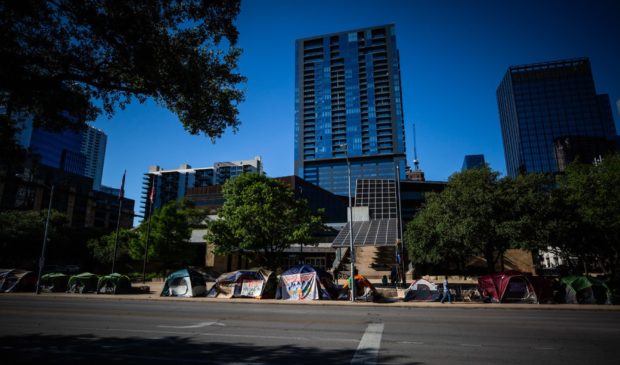Photo by Gabriel C. Pérez/KUT
Black leaders say Austin’s list of proposed sites for homeless camps is inequitable
Tuesday, May 25, 2021 by
Andrew Weber, KUT Black leaders in Austin called the city’s list of proposed sites for public encampments inequitable and criticized staffers for placing most of the locations east of Interstate 35.
The group on Monday called for a revision of the plan, which is less than a week old, at a news conference hosted by the Black Leaders Collective and Mayor Pro Tem Natasha Harper-Madison.
The plan was spurred by Austin’s reinstatement of a ban on public camping, which prohibits resting in certain areas and puts limits on panhandling.
Black leaders including Harper-Madison, Austin’s NAACP chapter President Nelson Linder and Travis County Commissioner Jeff Travillion said the city didn’t consider their input when drafting the map.
Harper-Madison, who saw the preliminary list of sites a day before it was released Tuesday, said the proposal isn’t equitable and was hastily drafted.
“The fact that nearly all of the proposed campsites are east of (Interstate) 35 indicates a mindset that the land and the people are expendable,” she said.
City staffers ultimately aim to put a temporary camp in each of Austin’s 10 City Council districts, but those gathered at City Hall on Monday noted the lack of infrastructure at the proposed sites east of I-35.
That lack of infrastructure, Harper-Madison and other speakers argued, goes all the way back to the city’s 1928 Master Plan, which forced Black Austinites to the city’s east side. She said the current camping plan is a continuation of that mindset “of sweeping all of its unwanted people and things to the east side of I-35.”
Harper-Madison said the majority of her East Austin Council district voted against reinstating bans on behavior related to homelessness and pointed out that the area already hosts the Salvation Army’s Rathgeber Center, as well as other nonprofits and housing developments that help people trying to get out of homelessness. She called on other districts to “start shouldering their fair share.”
One of the proposed sites is at Colony Park in Northeast Austin. Colony Park Neighborhood Association president Barbara Scott has been involved in efforts to build a health center in the neighborhood for the last 10 years. It’s a 208-acre tract of land without grocery stores, health care facilities and infrastructure, she said.
Scott said she had just gotten out of a meeting about the health center with city staff when she heard the city had suggested Colony Park as a possible campsite.
“How do you bring people to an area where there is no water, there is no electricity, there is not a grocery store?” she asked. “There is nothing in that area, and we have been fighting for the last 10 years – really the last 40 years … (and) this is unfair to those of us who live in the county and in the city of Austin.”
Travillion, who represents Precinct 1 in East Austin, said he hopes there’s a more open line of communication with the city going forward, and also with communities of color east of I-35.
“This was a tragically flawed process, because it did not include many of the most significant stakeholders,” he said. “It did not include the county, which provides a lot of programming resources. It did not involve neighborhood associations. It did not involve churches. It did not involve the places that influence activity in communities. We will never solve this problem sitting in an ivory tower. We must work with the people who are on the ground.”
Harper-Madison said the list is preliminary, but it shouldn’t have been published because it includes several unviable locations. Some sites are currently being developed by the city, like the 20-acre tract at St. Johns Avenue and I-35 that used to be a Home Depot. Some areas are within a floodplain or are at high risk of wildfire. Another site listed as a possibility is a city-owned cemetery.
“This process essentially is going to be set back by the fact that we’re having to deliberate a map where most of these locations aren’t even an option,” she said. “That’s a waste of time we don’t have. That’s a waste of resources we don’t have.”
This story was produced as part of the Austin Monitor’s reporting partnership with KUT.
The Austin Monitor’s work is made possible by donations from the community. Though our reporting covers donors from time to time, we are careful to keep business and editorial efforts separate while maintaining transparency. A complete list of donors is available here, and our code of ethics is explained here.
You're a community leader
And we’re honored you look to us for serious, in-depth news. You know a strong community needs local and dedicated watchdog reporting. We’re here for you and that won’t change. Now will you take the powerful next step and support our nonprofit news organization?



